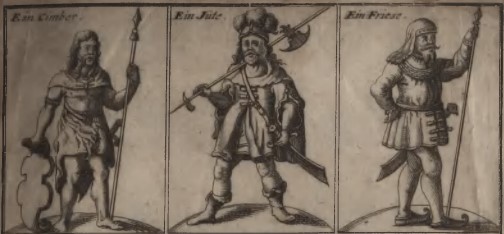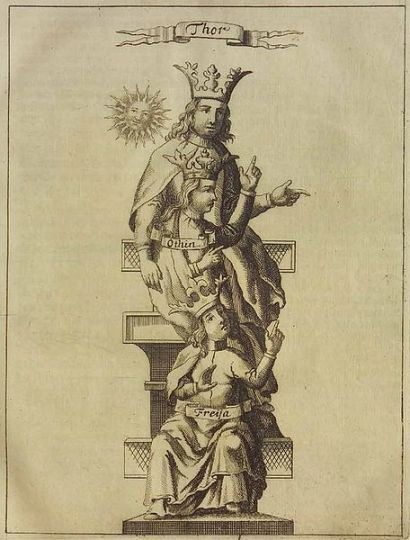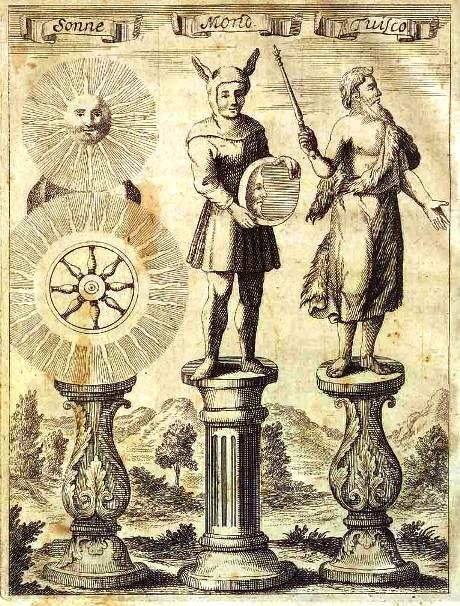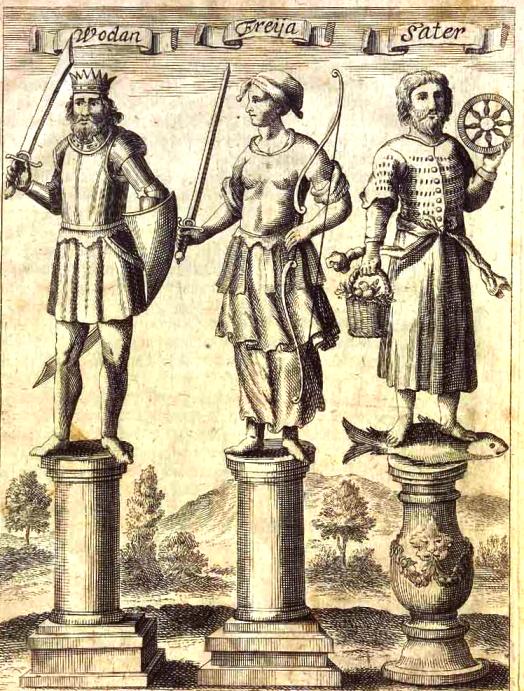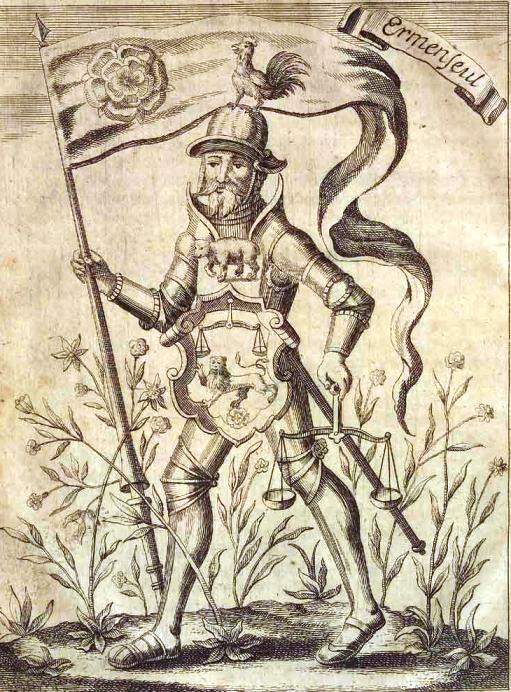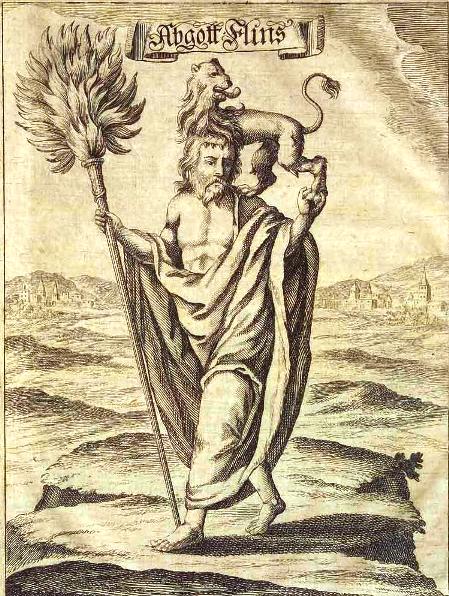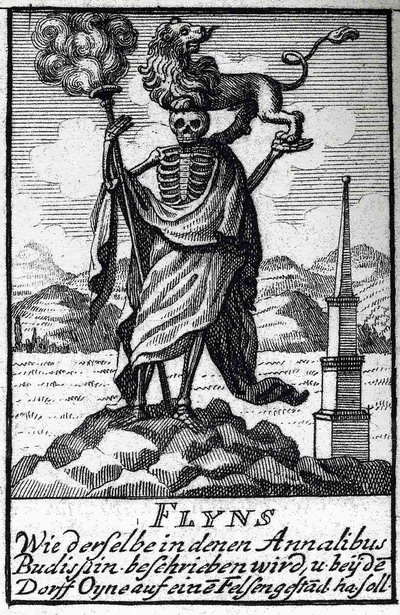|
|
THE LOST GODS OF GERMANY
|
Prior to the discovery and
dissemination of the Poetic Edda in 1643, these were the best
reports of the Gods of Northern Europe. The first translation
and full printing of the Eddic poems would not occur until
1787-1812. Thus Arnkeil's work gives us a glimpse of what the
Germanic pantheon looked like in the popular mind, before the
Codex Regius had been found.
Besides discussing the Gods of the Germanic tribes, as known at
the time, this book contains information and illustrations
of divinities and fantastic creatures from other world
mythologies. Here I have only included the images of the
dieties in the Germanic sphere. Some of the illustrations in
this book appear
to be based on those in Elias Schedius'
De Diis Germanis (1648). Some of these gods are familiar to
us and
others are not. Where the author cites a source for a deity, I
have provided the reference and any additional information where
possible.
The illustrations herein remained influencial into the early decades
of the 19th century, reprinted in other works or in derivative
form (see below).
|

Title Page |
THOR,
ODIN, FREIA
This image (left) is based on an
illustration from manuscript Nks 1867 4to of Snorri's
Edda (right). As told in the opening
scene of Gylfaginning, Swedish King Gylfi, in disguise
as Gangleri, questions
Hárr, Jafnhárr, and
Þriði— High, Just-as-High, and Third—presumably a threefold representation of Odin himself. The
author demonstrates his very limited knowledge of Snorri's Edda
beginning on page 86.
|
OTHIN, THOR, FRIGGE
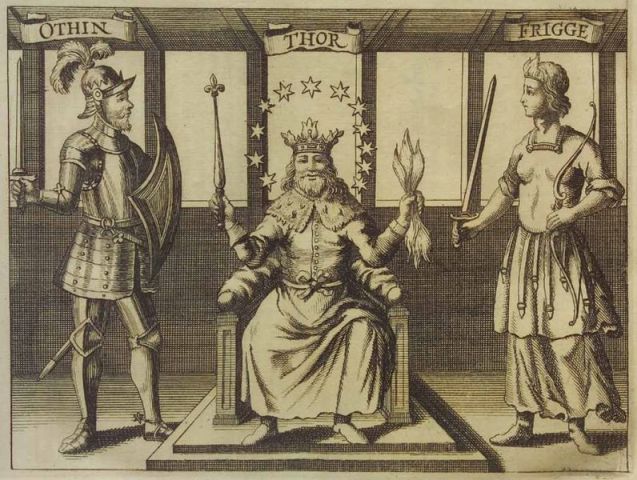
These images of
Odin, Thor and Frigg are based on a woodcut first published in
Olaus Magnus'
A Description of the Northern Peoples
(1555), which
also inspired
Richard Verstegan's Saxon Idols in Restitution of Decayed Intelligence in
Antiquities
(1605).
|
The Saxon Gods: The Namesakes of the Weekdays
Sun, Moon, Tuisco, Wodan, Thor (not
pictured), Freyja, Seater
|
THE GOLDEN HORN
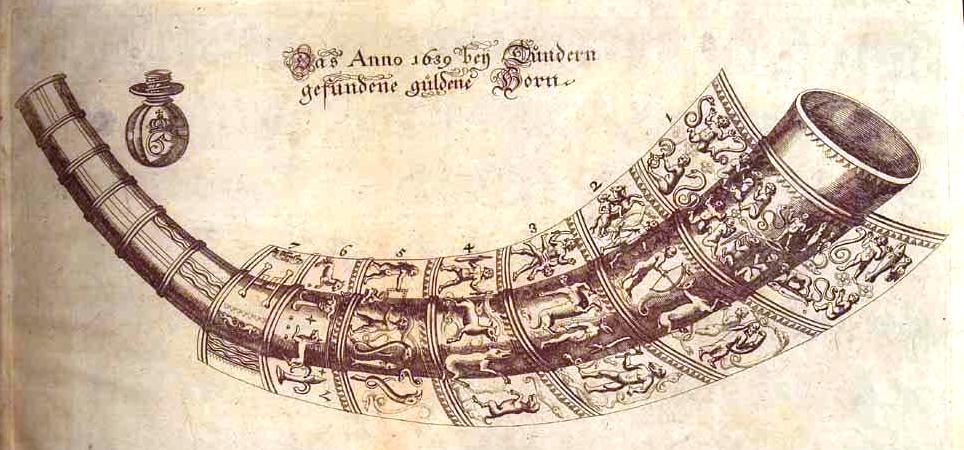
The illustrated horn clearly shows images of mythic
beings and creatures, including the lady with the mead
cup, twin gods, a three-headed giant, and animal-headed
beings. This is a drawing of the first of
two golden horns known today as the Gallehus Horns found
in 1639 and 1734. This horn, the longer of the two, had
seven segments with ornaments, to which six plain
segments and a plain rim were added, possibly in the
17th-century by a restorer. Both of the original horns
were stolen in 1805 and melted down.
|
|
FRO, MITOTHIN and VAGNHOFF

These images of
Freyr (Fro), Mitothin, and Vagnoff are based on a
woodcut from Olaus Magnus'
A Description of the Northern Peoples
(1555). Their names characters ultimately derive
from figures found in Books I-IX of Saxo
Grammaticus' Danish History. These gods are not
clearly identified in the original, however the text
appears to indicate that the first figure is
Mitothin, chief priest of the gods, and the second
is Freyr, a deputy of the gods. The name of the
third figure, Vagnoff, is probably a misreading of
Vagnhofthi, a giant who assists Hadding in the first
Book of Saxo's Danish History.
See Also Richard Verstegan's
Restitution of Decayed Intelligence in
Antiquities
(1605)
|
|
THE SAXON IRMINSUL
An Image of Mercury, also called Wodan
This image of the god Irminsul (left) is
clearly based on Conrad Bote (also called Botho)'s image of the Idol
Armesule in his Saxon Chronicle of 1492 (right):
These, in turn, appear to be related to an
illustration from Sebastian Münster's Cosmographia c. 1590
(right),
depicting a god of war and commerce:
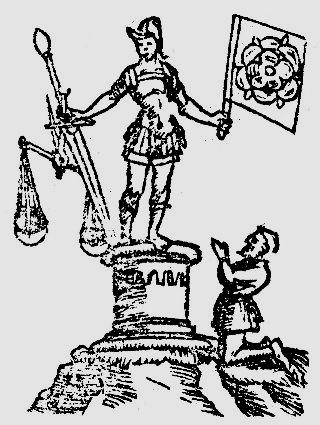
His inspiration for this is likely a reference
in the 12th century
Kaiserchronik, concerning
the origin of the designation Wednesday and
therefore probably describing the god Woden
(Odin), which reads:
| |
- ûf ainer
irmensiule
- stuont ain
abgot ungehiure,
- daz hiezen
si ir choufman.
|
"On an Irminsul
stands an enormous idol
which they call their merchant." |
|
An Irminsul is properly a kind of
pillar attested as an object of worship among the
ancient Saxon tribes. From this, a Germanic god Irmin,
inferred from the name Irminsul and the tribal name
Irminones, was once presumed to have been the national
god of the Saxons. The first reference to an Irminsul,
as the chief seat of the Saxon religion, appears in the
Royal Frankish Annals (772AD). During the Saxon wars,
Charlemagne repeatedly orders its destruction.
The Irminsul is described as located near Heresburg (now
Obermarsberg), Germany. Rudolf of Fulda (AD 865)
provides a description of an Irminsul in his De
Miraculis Sancti Alexandri ("The Miracles of Saint
Alexander"), chapter III, where he describes the
Irminsul as a great wooden pillar erected and worshipped
under the open sky.
A surprisingly late source
identifies the Irmunsul with an idol of the Roman God
Mercury, often identified as Woden or Odin in Medieval
European histories. The source links the Germanic god
Mercury directly to Frau Herra (a form of the name
Herke) as deities worshipped together by the ancient
Saxons. As such it’s worth quoting at length. The
author is Gobelin Person (also Gobelinus Persona,
1358-1421), a prominent historian and church reformer
from the bishopric of Paderborn, in North
Rhine-Westphalia, Germany. His main work, Cosmidromius,
completed in 1418, prior to the re-discovery and
dissemination of a single manuscript of Tacitus’
Germania in 1425, is one of the most important
historical works of the 15th century. In chapter 38,
written some time before 1406, speaking of local history
and superstition, he writes:
| |
"Charles the Great in the year of
our Lord 769, took hold of the reign in the
kingdom of the Franks and ruled for
forty-six years; of course, three years
together with his brother Carlomann and the
remainder of the years ruled alone. In the
second year of his reign, the General
Assembly of Worms convened to decide upon
the approach to the Saxon War, and they,
without delay, advanced altogether with
swords and fire to plunder the castle of
Eresburgh, which presently is called Mount
Mars in the Latin tongue, and seized the
idol which the Saxons call Irminsuel,
destroyed it and then took it back all the
way up to the Weser River, and withdrew with
twelve Saxon hostages. Understand that this
idol Irminsuel is Mercury or what the Greeks
call Hermes ... They consecrate the idol or
statue in the aforementioned place to this
god, because Irminsuel is a statue of he who
is called Hermes. And because in this
aforementioned place all men in the district
assemble in order to sacrifice to the idol
out of reverence and devote themselves to
it, that place is called Eresburgh, the
Mountain of Reverence. Actually, Juno, who
is called in the writings of the Greeks
Hera, was worshipped in the same place
before Hermes or perhaps at the same time,
thereupon they call that place Heresbergh,
which is clearly the Mountain of Hera or
Juno, and afterwards, when they occupied and
fortified that place, call it Heresburgh,
the Castle of Hera Veneration. Moreover,
this Hera was worshipped by the Saxons,
which can be seen by the fact that certain
of the common people recite what they
themselves have heard from the antiquity,
just as I myself have heard, that between
the festival of the Birth of Christ and the
holiday of the Epiphany of the Lord,
Mistress Hera flies through the air, because
the pagans assign the air to Juno. And
because Juno, whenever they call upon her as
Ceres and depict her with bells and wings,
the common people call her vrowe here (Frau
Here), or corrupt the name Vor Here de
Vlughet [of Flight], and believe that she
herself brings abundance at that time."
|
|
The significance of this
remarkable passage cannot be overstated. Written
prior to the discovery of Tacitius’ Germania in
1425, it clearly identifies a local Saxon god
with the Roman Mercury, information which can be
gleaned from only a few other sources. He
appears to speak of local belief recording what
“certain of the common people” say they
“themselves have heard from antiquity [or the
ancient elders], just as I myself have heard.”
Although he travelled widely throughout Italy in
the company of Pope Urban VI before being
ordained in 1386, Gobelin Person was a native of
Paderborn, Germany who was born, lived, worked,
and ultimately buried in the vicinity. Although
deeply learned, he was in a position to both
know and understand local legend. Remarkably, he
not only identifies the local Saxon goddess
known as Frau Herre with the Greek goddess Hera,
the Queen of the Classical pantheon, but also
with Ceres, the Roman goddess of agriculture,
demonstrating that the identification was based
on more than just a superficial similarity
between the names Herre and Hera. Clearly
drawing on local tradition which he himself has
heard, he says the common folk believe she flies
through the air at Christmas time bringing
abundance, adding the unique detail that she is
depicted with bells and wings. These details
immediately correspond to what we know of Frau
Holle, whose followers are known for ringing
bells, and her wings can be confirmed by images
in iconography and the mythology of the region,
which is well-acquainted with prophetic
goddesses in the form of birds. In addition,
Gobelin directly associates her worship with the
Classical god Hermes or Mercury, who is widely
recognized as Odin from other sources, and this
at least two decades before the re-discovery and
wide dissemination of Tacitus’ book on the
traits and traditions of the Germanic tribes! In
addition, he precisely pinpoints the time of her
flight as taking place between the Feast of the
Nativity and the Feast of the Epiphany,
corresponding to the Twelve Days of Christmas,
the exact time of the Wild Hunt in Northern
European belief.
All copies of Germania were lost during the
Middle Ages and the work was forgotten until a
single manuscript was found in Hersfeld Abbey
(Codex Hersfeldensis) in 1425. It was then
brought to Italy, where Enea Silvio Piccolomini,
later Pope Pius II, first examined and analyzed
the book. This sparked interest among German
humanists, including Conrad Celtes, Johannes
Aventinus, and Ulrich von Hutten and beyond. The
peoples of medieval Germany (the Kingdom of
Germany in the Holy Roman Empire) were
heterogenous, separated in distinct tribal
kingdoms, such as the Bavarians, Franconians,
and Swaibians, distinctions which remain evident
in the German language and culture after the
unification of Germany in 1871 and the
establishment of modern Austria and Germany.
During the medieval period a self-designation of
"Germani" was virtually never used, the name was
only revived in 1471, inspired by the
rediscovered text of Germania, to invoke the
warlike qualities of the ancient Germans in a
crusade against the Turks. Ever since its
discovery, treatment of the text regarding the
culture of the early Germanic peoples in ancient
Germany remains strong especially in German
history, philology, and ethnology studies, and
to a lesser degree in Scandinavian countries as
well.
For additional contemporary information on
Irminsul (Mercury) and Hera, see
Petrus Albinus,
Saxonum Historiue Progymnasmata, 1585
|
THE
GODDESS HERTHA
MOTHER
EARTH |
|
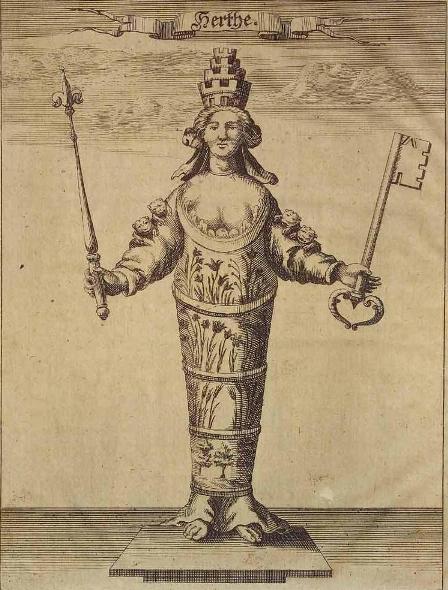
|
An illustration of the goddess Herthe known
from chapter 40 of Tacitus' Germania (c. 90AD)
which reads:
“The Langobardi are distinguished by
being few in number. Surrounded by many mighty
peoples they have protected themselves not by
submissiveness, but by battle and boldness. Next to
them come the Reudigni, Aviones, Anglii, Varini,
Eudoses, Suarines and Huitones protected by rivers
and forests. There is nothing especially noteworthy
about these states individually, but they are
distinguished by a common worship of Nerthus, that
is, Mother Earth, and believe she intervenes in
human affairs and rides through their peoples. There
is a sacred grove on an island of the Ocean, in
which there is a consecrated chariot draped with a
cloth, which the priest alone may touch. He
perceives the presence of the goddess in the
innermost shrine and with great reverence escorts
her in her chariot, which is drawn by female cattle.
There are days of rejoicing then and the countryside
celebrates the festival, wherever she deigns to
visit and to accept hospitality. No one goes to war,
no one takes up arms. All objects of iron are locked
away then and only then do they exercise peace and
quiet, only then do they prize them, until the
goddess has had her fill of society, and the priest
brings her back to the temple. Afterwards the
chariot, the cloth, and if one may believe it, the
deity herself are washed in a hidden lake. The
slaves who perform this office are immediately
afterwards swallowed up in the same lake. Hence
arises dread of the mysterious, and piety, which
keeps them ignorant of what only those who are about
to perish may see.” [—A.R.
Birley translation, 1999]
Prior to the work of modern scholars who
consider the reading Nerthum the most
accurate, this goddess was commonly known as
Herthus or Herthe based on a variant
reading found in some manuscripts. John McKinnell,
writing in Meeting the Other in Norse Myth and
Legend (2005), explains:
“The usually accepted stemma has three families, and
readings shared by the best manuscripts of any two
of them are thought likely to be correct. The best X
group manuscripts (Vatican, Cod. Vat. 1862, Leiden
UL XVIII Periz.Q.21) read Neithum; the best y
manuscripts (Cod. Vat. 1518, Codex Neapolitanus)
have Nerthum, and the best Z manuscript (Iesi,
Æsinas Lat. 8) reads Nertum. The sound /th/ did not
exist in classical Latin, though the spelling is
found in words derived from Greek or the Germanic
languages (such as thesaurus 'treasure', or the name
Theodoricus). Tacitus would therefore be unlikely to
introduce the spelling th gratuitously. In the
fifteenth century, the Italian scribes who produced
most of the earliest surviving manuscripts
(including the Iesi manuscript) would have a natural
tendency to replace th with t, as was consistently
done in their native language (see Italian tesoro,
Teodorico), but would be very unlikely to do the
reverse. Nerthum is therefore more probably correct
than Nertum. If both Y and Z should read Nerthum,
that reading must be preferred. A different stemma,
proposed by Robinson, has only two groups, and the
best manuscripts in both read Nerthum. Whichever
stemma is correct, Nerthum therefore seems the
likeliest reading, although it could represent
either a grammatically masculine Nerthus or a
grammatically neuter Nerthum.”
|
|
|
The
form Hertha is a false reading of comparatively modern origin.
In 1519, Rhenanus, the pious scholar who published Tacitus,
wrote Herthum for Nerthum, manifestly the same as the Old High
German Herda, earth. Based on his authority, the text of
Tacitus was uniformly given as Herthum up until 1817, when
editors such as Franz Passow restored Nerthum to the Latin text.
That the name Nerthus is grammatically masculine in form has
lead some critics such as Klaus von See
to conclude that Tacitus had no genuine information about the
cult of Nerthus other than this name, and therefore based his
account of the Germanic ‘god’ on the Roman cult of Magna Mater
(the Great Mother), a cult in which Tacitus was himself entitled
to participate.
Therefore, the most frequent objections to the authenticity of
the Nerthus cult are based upon superficial comparisons to its
Roman reflection, almost always ignoring their sharp contrasts.
Besides the superficial similarity of the designations Terra
Mater and Magna Mater, or more properly magna deum mater, “great
mother of the gods,”
scholars prone to compare the two point out the fact that both
cults included a public procession which terminated with the
ritual washing of the idol in a lake. The differences between
these cults, however, are not insignificant, and thus there is
little reason to suspect that Tacitus drew on his knowledge of
the Roman cult in his description of the Germanic Earth-Mother.
Tacitus describes the goddess in question as Terra Mater, not
Magna Mater. The Romans knew a Tellus or Terra Mater, who had a
different ceremony than the one attributed to Nerthus; cattle
were sacrificed to her on the 14th of April.
The worship of Cybele, the great mother of the gods, spread from
its chief sanctuary, Pessinus in Phrygia, to Greece by the early
fourth century and then on to Egypt and Italy. Heeding the
counsel of the Sibylline oracle concerning the threat of foreign
invaders, the Roman senate brought her worship to Rome in 204 BC
as the first officially sanctioned Eastern cult. Lucretius
provides one of the best descriptions of her festival,
considered decadent even by Roman standards, as it was
celebrated around the time of Julius Caesar.
In one telling of her story, the goddess was born a
hermaphrodite and was castrated at birth, leaving her female.
Attis, her consort, was the child of a nymph, impregnated by the
goddess’ discarded member. Cybele fell in love with Attis, but
grew jealous of him after he was unfaithful to her and so drove
him insane. He died from blood-loss after castrating himself.
This myth was reenacted during the festival. In her train, men,
known as Galli, castrated themselves in devotion to her,
following the example of Attis. Since this practice was outlawed
among the Romans, the Galli were all recruited from outside of
Rome. Once a year, decked out in their exotic feminine garments,
long hair and amulets, these self-mutilated eunuchs were allowed
to parade a statue of the goddess, seated in a chariot pulled by
wild lions, through the streets accompanied by the clatter of
cymbals and the sounds of tambourines. Gathered spectators threw
flower petals and coins before them. Bulls were ritually
slaughtered at her increasingly elaborate feasts.
During the rest of the year, the Senate confined the Galli to an
enclosed sanctuary and declared that no citizen had the right to
enter the annexes occupied by them or take part in their
frenzied orgies. In detail, this cult is quite unlike the
peaceful public procession of Nerthus, in which all iron objects
were locked away.
Instead of wild lions, her car was drawn by domestic cattle.
A single priest, rather than a motley crew, attended her and
only he was allowed to touch her sacred vehicle.
Although some scholars have pointed out possible foreign
models for Tacitus’ account of the Nerthus cult, it is more
probable that he based his account on native Scandinavian
tradition.
A divinity in a wagon is well-known in Germanic lore, thus
there is little need to speculate that Tacitus borrowed the
idea from Roman sources. According to Snorri’s Edda, Thor
drives a wagon drawn by goats, Freyr arrives at Baldur’s
funeral in a cart led by a boar, and Freyja rides in a car
pulled by cats. Njörd too is known as ‘god of the wagon’ in
a skaldic strophe cited in the primary manuscript of
Snorri’s Edda; where other manuscripts have Vana guð (‘god
of the Vanir’), Codex Regius has vagna guð.
The Big Dipper (Ursa Major) was commonly known as the Wain
or wagon. In skaldic poetry, Odin is known as runni vagna,
"mover of wagons"; vinr vagna, "friend of wagons";
vári
vagna "protector of wagons"; and valdr vagnbrautar, "ruler
of the wagon-road.” The sky itself, home of the gods, is
known as “the land of wagons (land vagna),” indicating that
the constellations were imagined as the gods circling the
heavens in their cars.
Other Germanic literary sources also support the procession
of an idol in a wagon among the northern European tribes. In
the latter half of the fourth century, the Church historian
Sozomen (c. 400–450 AD), writing of the dangers that beset
Ulphilas [Wulfias] among the heathen Goths, recounts how
Athanaric, chieftain of the Thervingians, appointed Winguric
(Wingureiks), a goði, to eradicate the Christian faith from
the land. He placed a xoanon (wooden idol) in an armamaxa
(covered carriage) and ordered it conveyed to the homes of
those suspected of practicing Christianity. If they refused
to fall down and sacrifice (evidently to the deity
represented by the statue), their tents were set ablaze.
Sozomen says:
“[Ulphilas] exposed himself
to innumerable perils in defense of the faith,
during the period that the aforesaid barbarians were
abandoned to paganism. He taught them the use of
letters, and translated the sacred scriptures into
their own language. …Athanaric resented the change
in religion that had been effected by Ulphilas; and
irritated because his subjects had abandoned the
superstition of their fathers, he imposed cruel
punishments on many individuals; some he put to
death after they had been dragged before tribunals
and had nobly confessed the faith, and others were
slain without being permitted to utter a single word
in their own defense. It is said that the officers
appointed by Athanaric to execute his cruel
mandates, caused a statue to be constructed, which
they placed on a chariot, and had it conveyed to the
tents of those who were suspected of having embraced
Christianity, and who were therefore commanded to
worship the statue and offer sacrifice: if they
refused to do so, they were burnt alive in their
tents. But I have heard that an outrage of still
greater atrocity was perpetrated at this period.
Men, women, and children, who were compelled to
offer sacrifice, fled from their tents and sought
refuge in a church, whither also they carried the
infants at the breast; the pagans set fire to the
church and consumed it, with all who were therein.”[16]
|
In Crimea, Winguric paraded the idol
before a tent used by Christians for their church service.
Those who honored the idol were spared, and the rest were
burned alive in their place of worship around the year 375
AD. A total of 308 people died in the fire, of which
twenty-one are known by name, written with multiple variants
in manuscript. A woman called Baren or Beride, also recorded
as Larisa, led the congregation in a hymn as the fire
consumed them. The so-called “26 Gothic Martyrs” linked to
this incident are commemorated on March 26 in the Christian
Orthodox calendar and on October 29 in the Gothic calendar
fragment, "in remembrance of the martyrs who with Werekas
the priest and Batwin the bilaif (minister?) were burned in
a crowded church among the Goths," gaminþi marwtre þize bi
Werekan papan jah Batwin bilaif aikklesjons fullaizos ana
Gutþiudai gabrannidai.[17]
It is noteworthy that Athanaric did not persecute Christians
in general, but primarily members of his own community who
had converted. Since the purpose of the procession seems to
be to promote prosperity, Carla O'Harris has suggested that
Anthanaric's true motivation in persecuting the coverts may
have been their unwillingness to participate in the
time-honored rituals that would insure the well-being of the
land, and therefore the community at large. His chosen means
of execution, death by fire, may indicate that Athanaric saw
the Christians as practitioners of witchcraft, whose
religious rites would offend the gods and thereby blight the
land.
Footnotes:
[16]
Historia Ecclesiastica VI, 37, translated by Edward Walford as
The Ecclesiastical History of Sozomen (1855), pp. 306-7.
[17]
George W. S. Friedrichsen, 'Notes on the Gothic Calendar (Cod.
Ambros. A)’, Modern Language Review 22 (1927); The ‘twenty-six’
martyrs include the twenty-one who are named, Batwin’s four
children, and an anonymous man who ran up to confess his faith
as the tent began to burn.
|
THE GOD SVETOVID (SVANTO-VITH)
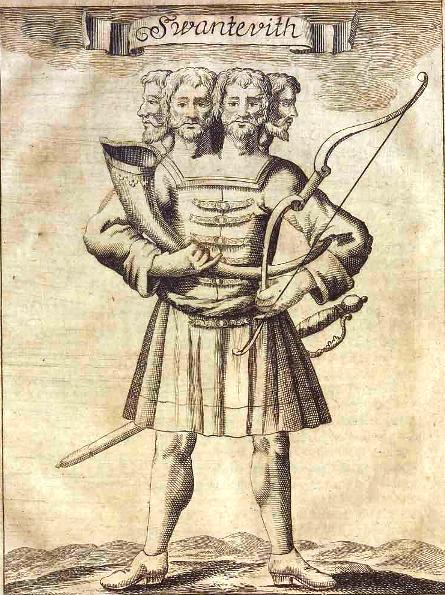
This evidence for this idol is a
passage in Book XIV of Saxo Grammaticus' Gesta
Danorum ("Danish History") written before 1220 AD.
There he describes a statue of Suanto-Vitus ("Saint
Vitus") in the following manner:
"[Waldemar I and Absalon lay siege to
Arkon in Rügen, a city on a ness with precipice
walls.]
"On a level in the midst of the city was to be seen
a wooden temple of most graceful workmanship, held
in honour not only for the splendour of its
ornament, but for the divinity of an image set up
within it. The outside of the building was bright
with careful graving [or
painting], whereon sundry shape were rudely and
uncouthly pictured. There was but one gate for
entrance. The shrine itself was shut in a double row
of enclosures, the outer whereof was made of walls
and covered with a red summit; while the inner one
rested on four pillars, and instead of having walls
was gorgeous with hangings, not communicating with
the outer save for the roof and a few beams.
In the temple stood a huge image, far overtopping
all human stature, marvellous for its four heads and
four necks, two facing the breast and two the back.
Moreover, of those in front as well as of those
behind, one looked leftwards and the other
rightwards. The beards were figured as shaven and
the hair as clipped; the skilled workman might be
thought to have copied the fashion of the Rügeners
in the dressing of the heads. In the right hand it
held a horn wrought of divers metals, which the
priest, who was versed in
its rites, used to fill every year with new wine, in order to
foresee the crops of the next season from the
disposition of the liquor. In the left there was a
representation of a
bow,
the arm being drawn back to the side. A tunic was
figured reaching to the shanks, which were made of
different woods, and so secretly joined to the knees
that the place of the join could only be detected by
narrow scrutiny. The feet were seen
close to the earth, their base being hid
underground. Not far off a bridle and saddle and
many emblems of godhead were visible. Men's marvel
at these things was increased by a sword of notable
size, whose scabbard and hilt were not only
excellently graven, but also graced outside with
[mounts or inlaying of] silver.
This image was regularly worshipped in the following
way: Once every year, after harvest, a motley throng
from the whole isle would sacrifice beasts for
peace-offering before the temple of the image, and
keep ceremonial feast. Its priest was conspicuous
for his long beard and hair, beyond the common
fashion of the country. On the day before that on
which he must sacrifice, he used to
sweep
with brooms the shrine, which he had the sole
right of entering. He took heed not to breathe
within the building. As often as he needed to draw
or give breath, he would run out to the door, lest
forsooth the divine presence should be tainted with
human breath. On the morrow, the people being at
watch before the doors, he took the cup from the
image, and looked at it narrowly; if any of the
liquor put in had gone away he thought that this
pointed to a scanty harvest for next year. When he
had noted this he bade them keep, against the
future, the corn which they had. If he saw no
lessening in its usual fulness, he foretold fertile
crops. So, according to this omen, he told them to
use the harvest of the present year now thriftily,
now generously. Then he poured out the old wine as a
libation at the feet of the image, and filled the
empty cup with fresh; and, feigning the part of a
cupbearer, he adored the statue, and in a regular form of address prayed for good increase of
wealth and conquests for himself, his country and
its people. This done, he put the cup to his lips,
and drank it up over-fast at an unbroken draught;
refilling it then with wine, he put it back in the
hand of the statue. Mead-cakes were also placed for
offering, round in shape and great, almost up to the
height of a man's stature. The priest used to put
this between himself and the people, and ask,
Whether the men of Rügen could see him? By this
request he prayed not for the doom of his people or
himself, but for increase of the coming crops. Then
he greeted the crowd in the name of the image, and
bade them prolong their worship of the god with
diligent sacrificing, promising them sure rewards of
their tillage, and victory by sea and land. ... [The
people keep orgy the rest of the day to please the
god.]
... Each male and female hung a coin every year as a
gift in worship of the image. It was also allotted a
third of the spoil and plunder, as though these had
been got and won by its protection. This god also
had 300 horses appointed to it, and as many
men-at-arms riding them, all of whose gains, either
by arms or theft, were put in the care of the
priest. Out of these spoils he wrought sundry
emblems and temple-ornaments which he consigned to
locked coffers containing store of money and piles
of time-eaten purple. Here, too, was to be seen a
mass of public and private gifts, the contributions
of anxious suppplicants for blessings. This statue
was worshipped with the tributes of all Sclavonia,
and neighbouring kings did not fail to honour its
sacrifice with gifts. ...[Even Sweyn gave a wrought
cup, and there were smaller shrines. ]
...Also it possessed a special white horse, the hairs of whose mane and
tail it was thought impious to pluck, and which only
the priest had the privilege of feeding and riding,
lest the use of the divine beast might become common
and therefore cheap. On this horse, in the belief of
Rügen, Suanto-Vitus —so the image was called—rode to
war against the foes of his religion. The chief
proof was that the horse when stabled at night was
commonly found in the morning, bespattered with mire
and sweat, as though he had come from exercise and
travelled leagues. Omens also where taken by this
horse, thus: When war was determined against any
district, the servants set out three rows of spears,
two joined crosswise, each row being planted point
downwards in the earth; the rows an equal distance
apart. When it was time to make the expedition,
after a solemn prayer, the horse was led in harness
out of the porch by the priest.
If
he crossed the rows with the right foot
before the left it was taken as a lucky omen of
warfare; if he put the left first, so much as once,
the plan of attacking that district was dropped;
neither was any voyage finally fixed, until three
paces in succession of the fortunate manner of
walking were observed. Also folk faring out on
sundry businesses took an omen concerning their
wishes from their first meeting with the beast. Was
the omen happy, they blithely went on with their
journey; was it baleful, they turned and went home.
Nor were
these people ignorant of the use of lots. Three bits
of wood black on one side, white on the other, were
cast into the lap. Fair, meant good luck; dusky,
ill.
Neither were their women free from this sort of
knowledge, for they would sit by the hearth and draw
random lines in the ashes without counting. If these
when counted were even, they were thought to bode
success; if odd, ill-fortune. [The king goes to
attack the town and efface profane rites. His men
make works, but he says these are needless] because
the Rügeners had once been taken by Karl Cæsar , and
bidden to honour with tribute Saint Vitus of Corvey,
famous for his sanctified death. But when the
conqueror died they wished to retain freedom, and
exchanged slavery for superstition, putting up an
image at home to which they gave the name of the
holy Vitus, and, scorning the people of Corvey, they
proceeded to transfer the tribute to its worship,
saying that they were content with their own Vitus,
and need not serve a strange one. [Vitus would come
and avenge himself, so the king prophesies; the
siege is related; the people trust their defences,
and guard] the tower over the gate only with emblems
and standards. Among these was Stanitia
[margin,
Stuatira], notable for size and hue, which
received as much adoration from the Rügeners as
almost all the gods together; for, shielded by her,
they took leave to assail the laws of God and man,
counting nothing unlawful which they liked. ... [the
town is taken and fired].
[The image could not be prized up without iron
tools. Esbern and Snio cut it down]. The image fell
to the ground with a crash. Much purple hung round
the temple; it was gorgeous, but so rotten with
decay that it could not bear the touch. There were
also the horns of woodland beasts, marvellous in
themselves and for their workmanship. A demon in the
form of a dusky animal was seen to quit the inner
part and suddenly vanish from the sight of the
bystanders. [The image of Suanto- Vitus is then
chopped into firewood.]"
[Asalon goes against the Karentines; takes the town,
and comes upon three temples of a similar kind to
that at Arkon.] The greater temple was situated in
the midst of its own ante-chamber, but both were
enclosed with purple [hangings] instead of walls,
the summit of the roof being propped merely on
pillars. So the servants, tearing down the rear of
the ante- chamber, at last stretched out their hands
to the inmost veil of the temple. This was removed,
and an oaken image which they called Rugie-Vitus
[Rügen's Vitus] was exposed on every side amid
mockery at its hideousness. For the swallows had
built their nests beneath its features, and had
piled a heap [of droppings on its breast. The god
was only fit to have his effigy hideously befouled
by birds. Also in its head were set seven faces,
after human likenesses, all covered under a single
poll, and the workman had also bound by its side in
a single belt seven real swords with their
scabbards. The eighth it held in its hand drawn;
this was fitted in the wrist and fixed very fast
with an iron nail, and the hand must be cut off
before it could be wrenched away: which led to the
image being mutilated. Its thickness was beyond that
of a human body, but it was so long that Absalon,
standing a-tip-toe, could scarce reach its chin with
the little axe he was wont to carry in his hand. The
people had believed this god to preside over wars,
as if it had the power of Mars. Nothing in this
image pleased the eye; its features were hideous
with uncouth gravings [or painting]. [It is cut
down, and its own people spurn it and are converted.
The assailants go on] to the image of Pore-Vitus,
which was worshipped in the next town. This was also
five-headed, but represented without weapons. On
this being cut down they go to the temple of
Porenutius. This statue representing four faces had
the fifth inserted in its bosom; its left hand
touched the brow, and its right the chin [It was
destroyed.]
—Oliver Elton Translation (1894)
|
|
THE GOD FLYNT
Conrad Bote of Brunswick in
his Saxon Chronicle (1492) says the deity of Death was
named Flins; and on the Spree, near Budissin, the
place where the idol was fixed still retains the
name of Flinstein, and is lithographed in
Preusker's Blicke, &c. (below), with the
spot more particularly designated where his figure
of solid gold is said to have stood, and to have
been thrown thence into the Spree below when the
Germans attempted to destroy this Wendic deity. Just
below the place is a cavern, said to extend to the
neighbouring village, with a room full of barrels of
gold. Independently of such general reports of
immense riches where heathen temples are believed to
have existed (and some numerous so-called
ring-monies at Carnac and elsewhere, with torques,
&c., would seem in some measure to countenance the
idea), more sure traces of a religious Pagan station
exists here in the tradition that it was a customary
penance to traverse from this place to the altar of
Zernibog, or Tchernebog, on the knees.
This deity has been alternately called Flins and
Flint or Flynt. Richard Verstegan, writing in Restitution
of Decayed Intelligence in Antiquities (1605),
describes the god pictured here in this manner:
"They adored also the Idoll FLYNT, who had that name
for his being set upon a great Flint stone. This
idoll was made like the Image of death, and naked,
save onely a sheete about him. In his right hand he
held a torch, or as they termed it, a fire blase. On
his head a Lyon rested his two fore-feet, standing
with the one of his hinder feet upon his left
shoulder, and with the other in his hand; which to
support, he lifted up as high as his shoulder."
On page 122, Arnkiel speaks of the god Flins who stands
on a flintstone as a Wendish god, citing his source as
Vetus Chron. Saxon a Pomario editum p. 245. Also
Schedius Syng. 3,
De Diis Germanis, ch. 7. And refers to his
worship by a Vandal king Vißlou (?) in the year 90 in
Swabia near Pommern and Brandenberg.
|
THE
GODS
RADEGAST, PRONE and SIWE
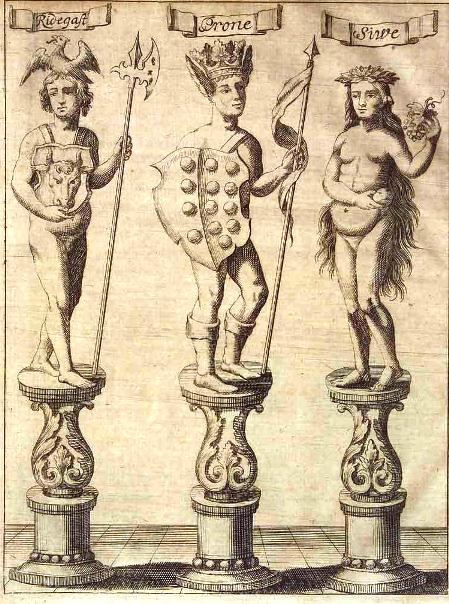
This image is clearly based on the one below from Bote's Saxon
Chronicle. |
| |
|

Conrad Bote of Brunswick's Chronicles of the
Saxons, 1492
On page 119, Arnkiel speaks of the Vandal
goddess Siva or Siwe of Polaber or Raßberg; and
Ridegast, the god of Obotrist or Meckelberg,
citing his
sources as Helmoldus Book I, ch. 53
and Albert Crantz, Wandalia Book 37. The
picture and the information given by Arnkeil
both appear to be drawn from Bote's Chronicle.
The principal works upon Lower
Saxony in the fourteenth century are
the Chronicle of Hermann Cornerus of Lübeck; in
the fifteenth, Albert Crantz's Saxonia and Vandalia,
as well as Conrad Bote of Brunswick's
Chronicle of the Saxons. The
direct Nether-Dutch
of Bote's Picture Chronicle,
printed at Mentz in 1492 under the title
Cronecken der Sassen [Saxon Chronicle], is
amply illustrated with woodcuts, including
several of heathen gods.
RADEGAST, “Dear
Guest” or “Good Guest”, is mentioned by Adam of
Bremen in his 10th century Gesta
Hammaburgensis Ecclesiae Pontificum as the
deity worshipped by the West Slavic Lutician
tribes in the city of Radgosc. In
his Chronica Slavorum, Helmold designated
Radegast as a Lutician god. However, in
his Chronicon, Thietmar of Merseburg wrote that
the pagan Luticians worshipped many gods,
in their holy city of Radegast, the most
important of which was named Zuarasici,
identified as Svarog. Johannes Scotus, Bishop
of Mecklenburg, was sacrificed to that god on 10
November 1066, during a Wendish rebellion
against Christianity according to Adam of
Bremen.
Mistevoi, the valiant prince of the Obotrites,
served under the banner of Otto II in Italy. On
his return home, he pursued the hand of the
sister of the Duke of Saxony. Upon being
insulted by a jealous rival, Dietrich of
Brandenburg, who called him a dog of a Slav, not
worthy to mate with a Christian bride, Mistevoi replied,
"If we Slavs be dogs, we shall show you we
bite." The pagan Slavs, ever ripe for revolt,
obeyed his call. An oath of eternal enmity
against the Germans and the priests was sworn
before their idol, Radegast, and they rose
suddenly in open rebellion (983 AD),
assassinating all who fell into their hands,
razing churches to the ground, and completely
destroying the cities of Hamburg, Oldenburg,
Mecklenburg, Brandenburg and Havelburg. The
heathen party, headed by Plasso, rose up and
extirpated Christianity, sacrificing John,
bishop of Mecklenburg, to their gods; stoning to
death St. Answar, Abbot of Ratzeburg, and
twenty-eight monks; assassinating Gotteschalk in
Lenzen at the foot of the altar; butchering Eppo
the priest as he was offering the Holy Sacrifice
upon the altar itself, and slaughtered the
rest of the Christians who were left in
the sanctuary. Altogether, sixty priests were flayed
alive. The heathens were, however, decisively
beaten back in a pitched battle at Tangermünde.
Prono, an idol of the ancient Slavonians
worshipped at Altenburg (Oldenburg) in Germany,
was a statue erected on a column, holding a
ploughshare in one hand , and in the other a
spear and a standard. Its head was crowned, its
ears prominent, and from one of its feet was
suspended a little bell.
The god Prone, also Prove,
is cited as appearing in Albert Crantz's Wandalia ch.
37; Schedius
De Diis Germanis; Conf. Bangeretti notas in
Helmoldus
Book 1, chapter 84.
Helmold, writing of the pagan revival among the
Wends in 1134, refers to "Prove deus
Aldenburgensis terrae," Prove, God of the
Oldenburg territory.
Bangert, in his notes to Helmold, notes the
variant spelling Prono, which has led some scholars to
associate the name with Perun. [Bangeretti notas
in Helmoldus
Book 1, chapter 84.
]
Helmold I, 84 “The Slavs have multiple modes of
idolatry, as not all of them practice the same
superstitions. Some erect strange statues in
temples, as for instance the effigy in Plön
which is named which is named Podaga,
other deities inhabit forests and groves, for
example Prove, the god of Oldenburg. Those are
not represented in any effigies. But many gods
are carved with two, three or even more heads.”
Helmold von Bosau describes the holy grove
of the god Prove, which grew a short
distance from the city of Starigard (modern
Oldenburg, Lower Saxony, Germany). Assemblies
were held and princely judgements pronounced
there. A cult centre, with another
sanctuary containing an idol of Prove, was located in
the princely stronghold at Starigard of the
Wagrians. The grove, which consisted of ancient
oaks, enclosed an atrium, surrounded by an
ornamental fence with two gates.
In the regions of present day northern Germany
and Poland, the Slavs clung fiercely to their
heathen religion until their final conversion,
accompanied by a savage destruction of their
idols in the twelfth and thirteenth centuries.
Presbyter Helmold provides a contemporary
account of how he helped destroy one such
"profane place" near Oldenburg in 1156. Led by
the bishop, he writes, "we entered the atrium,
leapt the fence around the sacred trees, and
having set fire to a pile of wood, made a
funeral pyre, not without fear, lest we be
overwhelmed by a tumult of the populace."
Ceroid, Christian bishop of Altenburg, destroyed
this idol with his own hand, and cut down the
grove in which it was worshipped.
|
|
FOSTA AND WEDA
Gods of the Frisians
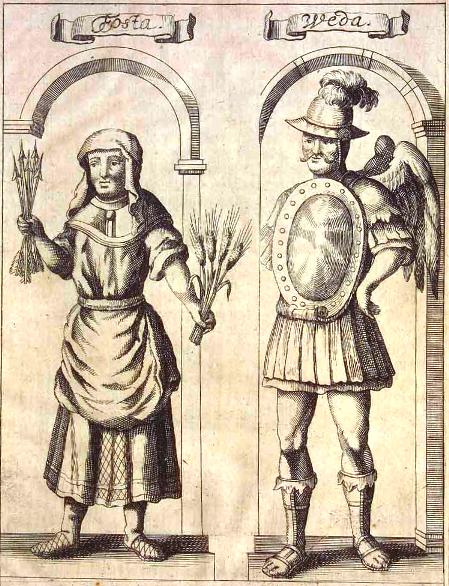
| On page 112,
Arnkiel states that the Frisans worshipped the
gods Foseta or Fosta and Weda when the Romans
came as described in the 8th chapter of
Book I of Walter's "Chron.
Fres," (Chapter 8 begins on p. 118). He goes
on to say that Mr. Heinrich Walter states that
the Frisians (Freschen) had four gods Phoseta or
Fosta, Freda, Meda and Weda. According to
p. 113, these gods appear in the "Nord-Freschen
Chronick". |
|
Nordfresische Chronik, M. Anton
Heimreichs, Chapter 8 (translated by Peter
Kröger):
"From the North
Frisians idolatry and funerals The North Frisian
have been at their first arrival pagan tribes,
such as the other tribes at the same time,
except Carolum M., lived in great idolatry.
Initially they did not build temples for their
gods or created depictions, as they considered
that they could not lock them into temples or
houses or depict them as human figures.
"For this reason they consecrated the
green trees with many branches and twigs and
worshiped there their gods. Later, as they dealt
with the Romans, they learned from them to erect
temples and depictions. As the maps show there
was at Everschup near Garding a Templum Martis,
in Uthholm south of Süderbever Templum Medae and
in Eiderstedt near Cating Templum Wodae; in
Nordstrand at the Süderog Templum Veneris and
north of the Hoge Templum Saturni, but in
Norgößharde Templum Martis, namely at the place
where the church of Borkum stands (I was told
that at this place in former times a pagan
church stood) and in Osterharde on (the island)
Amrum Templum Saturni and Phostae and on (the
island) Sylt near Niblum Templum Veneris such as
at the same place Templum Phostae, Wodae, Martis
and Saturni stood.
"The Frisians especially honored and
worshiped primarily four idols, with the names
Phoseta or Fosta, Freda, Meda and Woda. Of
these, Meda and Phoseta had in his right hand
some arrows, and in the left hand a sheaf of
corn; but Freda and Woda had on their breast a
shield, a helmet on the head, at arms and legs
they were naked, and they had wings on their
back; leading to the conclusion that the former
have been worshiped in agriculture, but the
others were worshipped during wars. And I have
seen on the 12 June Anno 1650 depictions of
Phostä and Wödä seen next to a large horn,
whereby the people have been summoned for
idolatry in S. Mary's Church at Utrecht itself.
But among the idols Phoseta has been the most
noble one, who has been the Vesta of the mother
of Saturni who was named so as she decorated the
earth with flowers herbs and fruits, and which
has been the most honored in all Frisian
countries, of which also Heiligland (‘Holy
Land’) (which is also called Farrö or Farria
Insula) formerly Fosetis, Fostis and Phosteland
was called; and Heiligland, because there from
time immemorial have been performed many
pilgrimages to the forests and the pagan temples
of Phostä or Vestae.
"On their feast
days they danced and jumped after finishing of
idolatry and they worshiped their idol Kom, of
which Mr. Richardus Petri sent me messages from
the Föhringer country where he raised the idea
that the same is Deus Komus comessationum
nocturnarumque saltationum praeses, which
is a God of eating and night dances. Such
pagance as Bonifacius called it or pagan customs
have not be abolished by the church easily,
because not only the behaviour at these places
was kept by the papacy that on Sundays and
especially on the high festivals there was
dancing, as Mr. Richardus Petri told me, that
old people still could tell that at their time
many young women on Westerlandföhr, at the
Westerkirchhofpforten danced into the new year
and on the afternoon after the church service."
|
The following map
showing the temple of "Fostæ and Phoseta c. 768"
(upper left) was first printed in
Travels in Various Countries of Europe,
Asia and Africa. 3. Ed by
Daniel Edward Clarke (1819).
|
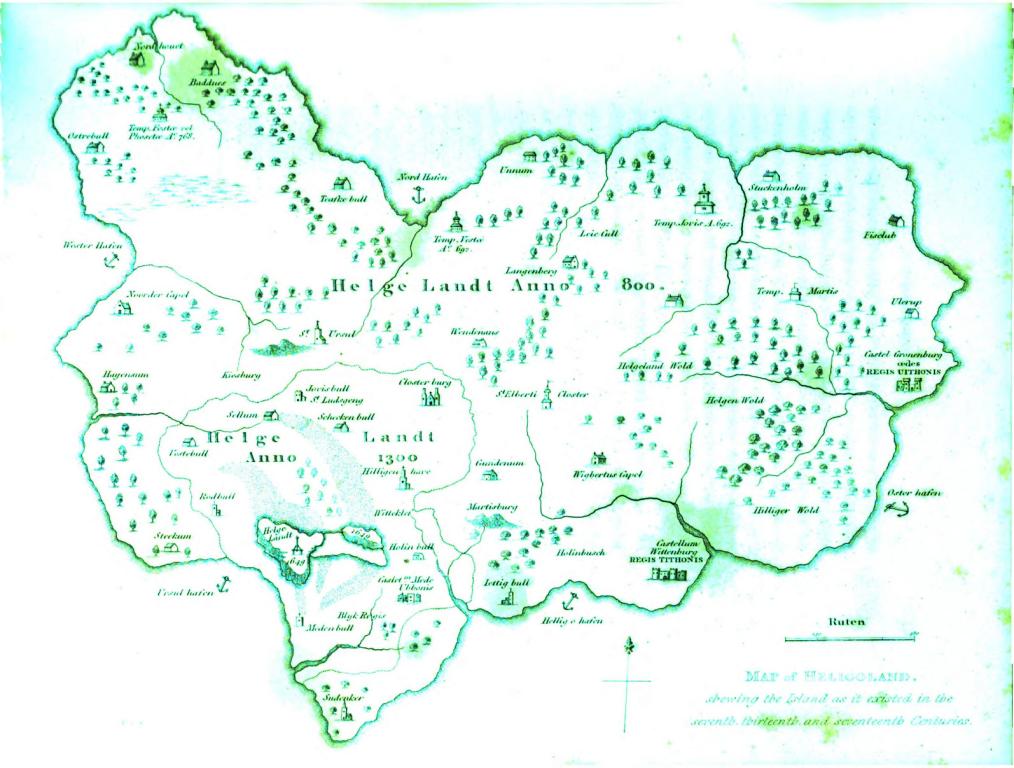 |
|
Derivative Works
|
1728 Elias
Schedius
De Diis Germanis
1826 Christian August Vulpius
Handwörterbuch der Mythologie
1837 Leopold Ziegelhauser
Allgemeine Populäre Götterlehre
|
|
|
|
